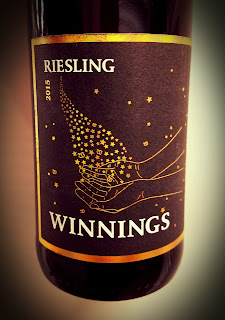Here's a throwback for Halloween, from a time when I wrote a series of columns pairing wine and movies for Trailers From Hell, a really great website that all movie lovers should check out. They are kind enough to still have some of those chestnuts digitally preserved, which you can peruse here, if you wish.
This is how the article appeared when it ran seven years ago:
The holiday season doesn't really get going until we can hear the turkeys running for their lives. For those of us who live to pair wine with things, however, there's always a holiday just around the corner. Groundhog Day, Bastille Day, National Cheese Day - they are all perfectly good reasons to crank out - er, craft - an article on which wines will best complement the occasion. The annual, end-of-summer "drink that rosé before last call" columns are particular favorites of mine. Even Texas Independence Day - oh, hell, let's not go there again.
Next on the list of official holidays is Halloween, a holiday which seems to get a lot of attention in Tinseltown. It may well be the worst traffic day all year in Los Angeles, especially in the late afternoon and early evening when the ghosts, goblins and Lady Gagas hit the streets to grab some goodies. A recent poll shows Halloween to be America's third favorite holiday, behind Christmas and Thanksgiving.
Trick-or-treating may be for kids, but adults give it their best shots, too, with countless parties held for the purpose of answering the door and distributing hundreds of dollars worth of packaged tooth decay. I am assuming you're not one of those types who turns off the porch light and sits in the dark pretending you're not home.
Anyhow, Halloween is a bad night to sit in the dark. Just ask all those people who get bumped off in John Carpenter's "Halloween." They may be trick-or-treating outside, but on the screen it's not child's play.
TFH Guru Adam Rifkin calls "Halloween" a cinematic game changer. After this one, just being scary wasn't enough anymore. If Jack-O-Lanterns didn't send a shiver up your spine before this film, they surely did afterward.
The camera's focus on the Jack-O-Lantern's eye in the opening sequence sets the tone for the rest of the movie. We're given a "killer's eye view" of the goings on that occur on that fateful October 31st. The killer - social misfit Michael Myers - is evil enough for all the damned souls loosed upon the world for this one night each year.
Carpenter's touch with the evil he depicts is tasteful enough - the scares don't stop, but it's not really a gorefest. That stuff really happens in the most dangerous place of all - your imagination.
Here's a smattering of tasteful - and tasty - wines and wine things that may just make your Halloween party frightfully fun:
Vampire Vineyards - This outfit has vampire-themed wines - and vodka - perfect for any occasion, but especially this one.
Witch Creek Winery - If your broomstick can fly to San Diego, pick up some of this in Carlsbad on your way.
Graveyard Vineyards - Their Tombstone Red and Tombstone White are from Paso Robles.
Poizin Red Blend - It comes packed in a coffin.
Twisted Oak River Of Skulls Mourvedre - Calavaras County juice that's scary good.
Pumpkin Wine - Wisconsin's Three Lakes Winery sells this year-round.
Halloween "Ghost Party" Wine Glass
Jack O'Lantern Golf Resort - Oh, the screams from the first tee! A course sure to give you the yips. Don't get too far into the rough. Michael Myers may be in the foursome ahead of you.
Follow Randy Fuller on Twitter















